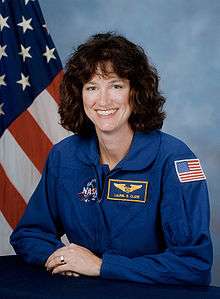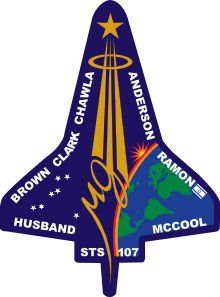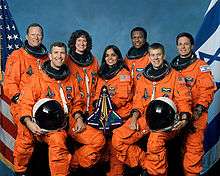Laurel Clark
| Laurel Blair Salton Clark | |
|---|---|
 Laurel Clark in August 1996 | |
| NASA Astronaut | |
| Nationality | American |
| Status | Deceased |
| Born |
March 10, 1961 Ames, Iowa, U.S. |
| Died |
February 1, 2003 (aged 41) Over Texas |
Previous occupation | Flight surgeon |
| Rank | Captain, U.S. Navy |
Time in space | 15d 22h 20m |
| Selection | 1996 NASA Group |
| Missions | STS-107 |
Mission insignia |
|
| Awards |
|
Laurel Blair Salton Clark (March 10, 1961 – February 1, 2003) was an American medical doctor, United States Navy Captain, NASA astronaut and Space Shuttle mission specialist. Clark died along with her six fellow crew members in the Space Shuttle Columbia disaster.
Early life
Clark was born in Ames, Iowa, but considered Racine, Wisconsin, to be her hometown. She is survived by her husband, fellow NASA flight surgeon Dr. Jonathan Clark (who was part of an official NASA panel that prepared the final 400-page report about the Space Shuttle Columbia disaster), and son, Iain.[1]
Clark was a member of the Gamma Phi Beta sorority. She held a Federal Communications Commission (FCC) issued Technician Class amateur radio license with the call sign KC5ZSU.
Education
- 1979: Graduated from William Horlick High School, Racine, Wisconsin
- 1983: Received Bachelor of Science degree in Zoology from the University of Wisconsin–Madison
- 1987: Received Doctorate in Medicine from the University of Wisconsin–Madison
Organizations
Clark was a member of the Aerospace Medical Association and the Society of U.S. Naval Flight Surgeons. She was also a member of the Olympia Brown Unitarian Universalist Church in Racine, Wisconsin.[2]
Military career
During medical school she did active duty training with the Diving Medicine Department at the United States Navy Experimental Diving Unit in March 1987. After completing medical school, Clark underwent postgraduate medical education in pediatrics from 1987 to 1988 at the National Naval Medical Center. The following year she completed Navy undersea medical officer training at the Naval Undersea Medical Institute in Groton, Connecticut, and diving medical officer training at the Naval Diving and Salvage Training Center in Panama City, Florida. Clark was designated a Radiation Health Officer and Undersea Medical Officer. She was then assigned as the Submarine Squadron 14 Medical Department Head in Holy Loch, Scotland. During that assignment she dove with Navy divers and Naval Special Warfare Unit Two SEALs and performed many medical evacuations from US submarines. After two years of operational experience she was designated as a Naval Submarine Medical Officer and Diving Medical Officer.
Clark underwent six months of aeromedical training at the Naval Aerospace Medical Institute st NAS Pensacola in Pensacola, Florida, and was designated as a Naval Flight Surgeon. She was stationed at MCAS Yuma, Arizona, and assigned as Flight Surgeon Marine Attack Squadron 211 (VMA-211), a Marine Corps AV-8B Harrier squadron. She made several deployments, including one overseas to the Western Pacific, practiced medicine in austere environments, and flew on multiple aircraft. Her squadron won the Marine Attack Squadron of the Year award for its successful deployment. She was then assigned as the Group Flight Surgeon for Marine Aircraft Group 13 (MAG-13).
Before her selection as an astronaut candidate she served as a Flight Surgeon for Training Squadron 86 (VT-86), the Naval Flight Officer advanced training squadron for tactical jets at NAS Pensacola. Clark was Board Certified by the National Board of Medical Examiners and held a Wisconsin Medical License. Her military qualifications included Radiation Health Officer, Undersea Medical Officer, Diving Medical Officer, Submarine Medical Officer, and Naval Flight Surgeon. She was a Basic Life Support Instructor, Advanced Cardiac Life Support Provider, Advanced Trauma Life Support Provider, and Hyperbaric Chamber Advisor.
NASA career
Selected by NASA in April 1996, Clark reported to the Johnson Space Center in Houston, Texas in August 1996. After completing two years of training and evaluation, she was qualified for flight assignment as a mission specialist. From July 1997 to August 2000 Clark worked in the Astronaut Office Payloads/Habitability Branch. Clark flew aboard STS-107, logging 15 days, 22 hours and 21 minutes in space.[3][4]
Space flight experience
STS-107 Columbia – The 16-day flight was a dedicated science and research mission. Working 24 hours a day, in two alternating shifts, the crew successfully conducted approximately 80 experiments. Clark's bioscience experiments included gardening in space, as she discussed only days before her death in an interview with Milwaukee media near her Wisconsin hometown. The STS-107 mission ended abruptly on February 1, 2003, when Columbia disintegrated and her crew perished during re-entry, 16 minutes before scheduled landing.
Clark also recorded inside the cockpit during Columbia's descent into the Earth's atmosphere on a small digital camera.[5]
Clark's final message to her friends and family was through an email sent from Columbia.[6][7]
Awards and decorations
Clark was awarded numerous insignia and personal decorations including:
Qualification insignia
- Naval Astronaut/Flight Surgeon
- Naval Flight Surgeon
- Diving Medical Officer
- Submarine Medical Officer
Personal decorations
- Defense Distinguished Service Medal †
- Navy and Marine Corps Commendation Medal with 2 gold award stars (3 awards)
- Congressional Space Medal of Honor †
- NASA Distinguished Service Medal †
- NASA Space Flight Medal †
- National Defense Service Medal
- Overseas Service Ribbon
The † symbol indicates a posthumous award.
Tributes
- Asteroid 51827 Laurelclark was named for Clark.[8]
- Clark Hill in the Columbia Hills on Mars was named for Clark.[9]
- L. Clark, an interior crater of the lunar crater Apollo, was named for Clark.[10]
- Clark Hall, in the Columbia Village Suites at the Florida Institute of Technology, is named after her. The apartments were initially planned to be named the Crane Creek Suites, but were renamed in 2008 to commemorate the Columbia crew.
- The Laurel Salton Clark Memorial Fountain in Racine, Wisconsin is named for her.[11]
- In 2004, the Naval Aerospace Medicine Institute named its Aerospace Medicine Academic Center in Pensacola after Clark and David M. Brown[12]
- Clark Auditorium at Walter Reed National Military Medical Center, Bethesda, Maryland is named for her and displays uniforms, training manuals, and personal items that belonged to her.
- The Scottish band Runrig pays tribute to Clark in its song "Somewhere" on its 2016 album The Story.[13]
References
- ↑ Lost Astronaut’s Husband Not Giving Up On Space - Milwaukee News Story - WISN Milwaukee
- ↑ http://archive.uua.org/news/2003/030214.html
- ↑ "Astronaut Bio: Laurel Blair Salton Clark 5/04".
- ↑ Becker, Joachim. "Astronaut Biography: Laurel Clark".
- ↑ "Columbia crew cheerful on tape before disaster - Tucson Citizen Morgue, Part 2 (1993-2009)".
- ↑ "HSF - STS-107 Memorial - Laurel Clark".
- ↑ Letter Home from Space January 31, 2003.
- ↑ "51827 Laurelclark (2001 OH38 )". JPL Small-Body Database Browser. Jet Propulsion Laboratory. October 2, 2003. Retrieved August 10, 2016.
- ↑ Savage, Donald (February 2, 2004). "NASA Dedicates Mars Landmarks To Columbia Crew". NASA News (Release no. 04-048). NASA. Retrieved August 10, 2016.
- ↑ Cowing, Keith (February 1, 2011). "Lunar Craters (Provisionally) Named for Columbia Astronaut s". NASA Watch. Retrieved August 10, 2016.
- ↑ Chien, Philip (2006). Columbia: Final Voyage. Springer Science & Business Media. p. 414. ISBN 9780387271491.
- ↑ Duren, Rod. "Navy Names Training Facility For Fallen Astronauts". America's Navy (August 27, 2004). U.S. Navy. Retrieved August 10, 2016.
- ↑ "Skye rockers Runrig prepare for their final album". The Scotsman. January 30, 2016. Retrieved 2016-08-05.

